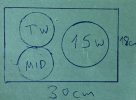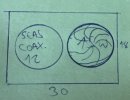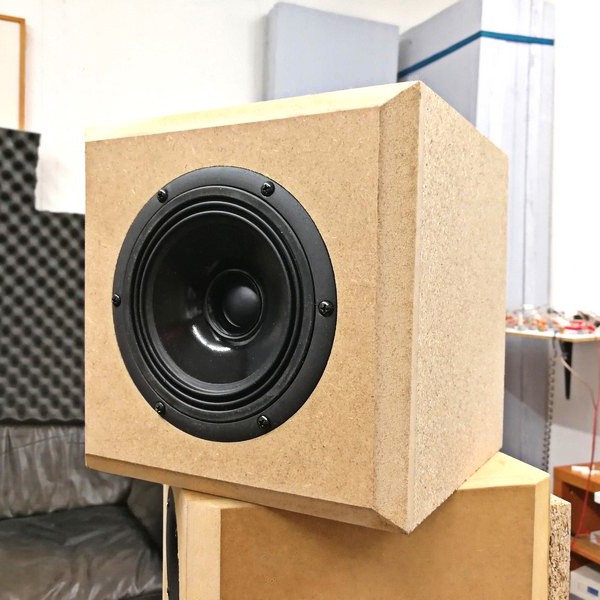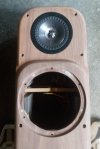Hello everyone.
Hope you are doing splendid.
I am thinking of building some Active X-Over Nearfield Monitors.
Lets not go into „why" i want to do it and „you cant compete with commercial designs“ territory. I am they type of person that has opened (and sometimes destroyed in the process)
devices just to look inside. Without any reason. I have always had a fascination about audio equipment and music for the last 30+ years . (ok for music a bit longer than that)
So i am looking at 3 ways such as Atc Scm 25 etc and for some reason this is the architecture of driver placement i like the most. Cant explain it. I just i like it optically-aesthetically.
Since i am going to sit long hours in front of them they need to be pleasing for my sight.
Plan A is. "3way Mini monitor“ Woofer-Midrange-Tweeter ,
Plan B is still 3 way but Woofer+ Coaxial Driver
that said each design and depending on the driver size and enclosure size has pros and cons. Especially considering that for my purpose 2 way or even coaxial would probably be better suited and easier to accomplish.
The aimed size will be 4 and maximum 5 liters of internal volume. The Speakers will not be required to play lower than 70-90hz.
Subwoofer is near me aprox 1 meter away. No issues crossing at these regions regarding directivity or acoustically "locating subwoofer“.
Of course in such a small monitor a midrange might be obsolete , but….,,,,,still love 3-way monitors optically.
Ok to the main dish now.
I am thinking on keeping my Scan Speak 15w 8530 K00 woofers as this still goes -F3 of around 80hz before i even High pass it with MiniDsp and simply is a superb driver.
So i am thinking. Guide Lines-Aims
1) What Midrange?
2) What tweeter?
3) Cost- I don`t need Beryllium tweeters. Also i don`t like Ribbon or Air Motion transformers ,,,, basically only option is Dome tweeters .
Aluminum or Soft Dome i am open to suggestions. Budget is not endlessly big so a bit of restrain is welcomed
4) Drivers have to be as linear as it gets before even starting correcting the frequency plot. Some candidates for a tweeter would be Wavecor TW030WA09 or Scan-Speak Discovery D2604 / 833000.
Pros and Cons of stuffing 3 drivers on an enclosure that will realistically be around 28-32 cm wide and around 18-20 cm height?
What about baffle step, Edges diffraction etc?
Distance to Monitors is between 80-100 cm from my ears.
The Scenario B- Coaxial is similar size cabinet but combining the 15W with a Seas Excel C16N001 coacxial driver or the little brother L12RE/XFC
Regardless of which design and the disadvantages the only option for placement is the speakers laying on their sides.
Update: Budget let’s say max 500-600 euros for 2xTweeter + 2xMidrange
The seas coax cost around 400 a pair.
The design will be completely active, meaning MiniDsp x-over and each driver will get its own amplifier channel.
happy to hear your thoughts and forgive my English
Hope you are doing splendid.
I am thinking of building some Active X-Over Nearfield Monitors.
Lets not go into „why" i want to do it and „you cant compete with commercial designs“ territory. I am they type of person that has opened (and sometimes destroyed in the process)
devices just to look inside. Without any reason. I have always had a fascination about audio equipment and music for the last 30+ years . (ok for music a bit longer than that)
So i am looking at 3 ways such as Atc Scm 25 etc and for some reason this is the architecture of driver placement i like the most. Cant explain it. I just i like it optically-aesthetically.
Since i am going to sit long hours in front of them they need to be pleasing for my sight.
Plan A is. "3way Mini monitor“ Woofer-Midrange-Tweeter ,
Plan B is still 3 way but Woofer+ Coaxial Driver
that said each design and depending on the driver size and enclosure size has pros and cons. Especially considering that for my purpose 2 way or even coaxial would probably be better suited and easier to accomplish.
The aimed size will be 4 and maximum 5 liters of internal volume. The Speakers will not be required to play lower than 70-90hz.
Subwoofer is near me aprox 1 meter away. No issues crossing at these regions regarding directivity or acoustically "locating subwoofer“.
Of course in such a small monitor a midrange might be obsolete , but….,,,,,still love 3-way monitors optically.
Ok to the main dish now.
I am thinking on keeping my Scan Speak 15w 8530 K00 woofers as this still goes -F3 of around 80hz before i even High pass it with MiniDsp and simply is a superb driver.
So i am thinking. Guide Lines-Aims
1) What Midrange?
2) What tweeter?
3) Cost- I don`t need Beryllium tweeters. Also i don`t like Ribbon or Air Motion transformers ,,,, basically only option is Dome tweeters .
Aluminum or Soft Dome i am open to suggestions. Budget is not endlessly big so a bit of restrain is welcomed
4) Drivers have to be as linear as it gets before even starting correcting the frequency plot. Some candidates for a tweeter would be Wavecor TW030WA09 or Scan-Speak Discovery D2604 / 833000.
Pros and Cons of stuffing 3 drivers on an enclosure that will realistically be around 28-32 cm wide and around 18-20 cm height?
What about baffle step, Edges diffraction etc?
Distance to Monitors is between 80-100 cm from my ears.
The Scenario B- Coaxial is similar size cabinet but combining the 15W with a Seas Excel C16N001 coacxial driver or the little brother L12RE/XFC
Regardless of which design and the disadvantages the only option for placement is the speakers laying on their sides.
Update: Budget let’s say max 500-600 euros for 2xTweeter + 2xMidrange
The seas coax cost around 400 a pair.
The design will be completely active, meaning MiniDsp x-over and each driver will get its own amplifier channel.
happy to hear your thoughts and forgive my English
Last edited:





